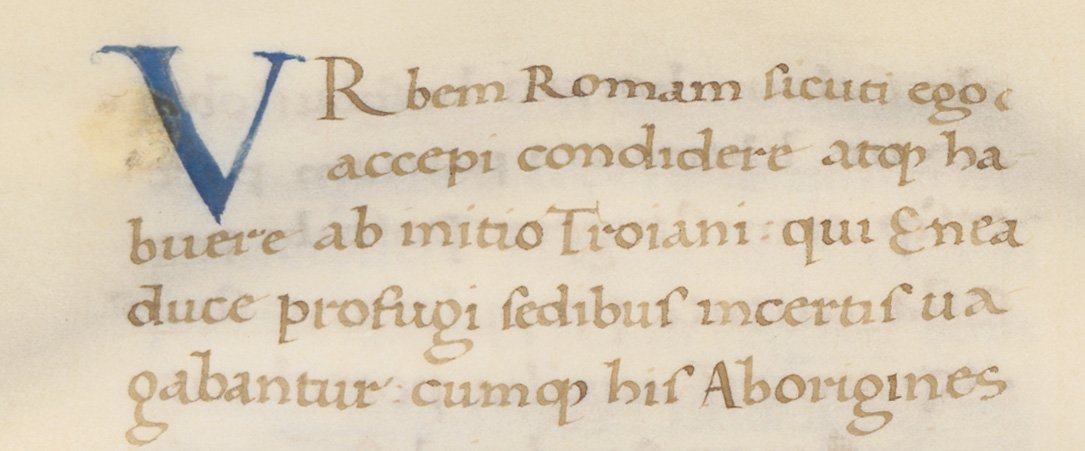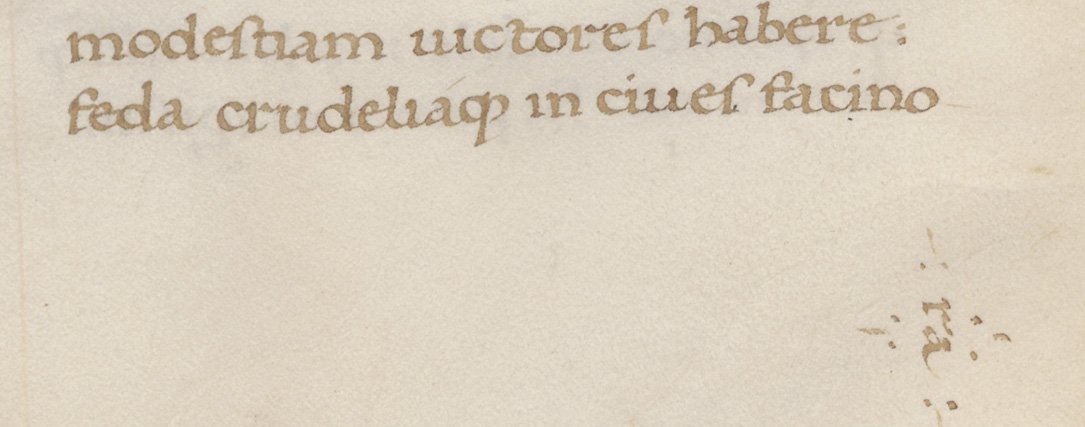'Bellum Catilinae' by Sallust
Sallust in Utrecht: a tradition spanning fifteen centuries
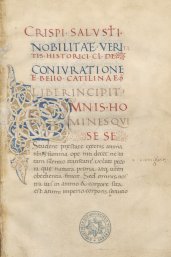
The clean and soberly made manuscript, Utrecht University Library, Ms. 1662, contains Renaissance era copies of Sallust’s Bellum Catilinae and Bellum Jugurthinum, two of the great historiographical works of Rome’s late Republican period. The production of this particular manuscript most likely took place in Italy during the second half of the 15th century. So, the works of Sallust continued to be copied and read for more than 1500 years, for a part because Sallust continued to be relevant in the political discourse, even up to the modern period.
Enemies of Rome
The Bellum Catilinae and Bellum Jugurthinum are the only extant complete works produced by their author, who probably wrote them between the years 44 and 40 BC. Sallust himself is not only known to us as a writer and historian, but also as a fierce loyalist of Julius Caesar. Sallust supported him first as a general in the Great Roman Civil War (49-45 BC), and then briefly as a proconsular governor. Forced to retire into private life in 44 BC, he spent the rest of his life working on his Catilina, which tells the story of Lucius Sergius Catilina’s failed coup d’état, on the career of Jugurtha, recounting of Rome’s struggles against the Numidian king, and the so called ‘Histories’, of which only fragments remain. His works contain a strong moralising message, and are a unique source of information for those studying the economic, social and political changes in Rome from 113 to 63 BC (Mellor 1999, 30-47).
Scholarly interest
This said, the question remains of how we can explain the presence of this manuscript copy of Sallust in the Netherlands. All in all, the answer seems to be connected to the attractiveness of the works throughout the Middle Ages. Sallust’s Catilina and Jugurtha can indeed be considered among the most popular pieces of historical writing throughout the later Middle Ages and the Early Modern Period, enjoying a steady popularity not only in Italy, but also in Germany, France, England and the Low Countries. The grounds for this fortune can be found in the richness of the information offered by the texts: not only were they a source of linguistic, historical and general philosophical wisdom, but they also held particular influence in shaping the concept of republican liberty in European towns and communities from the late 13th century on. An extensively studied case of the latter development can be found in Renaissance Tuscany, where the figure of Catiline became a complex icon of depravity, treason, but also of chivalry, and was often discoursively used in texts on political matters (Osmond 1995).
Sallust in the Low Countries
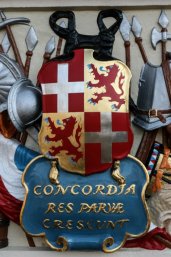
Enquiries on the texts’ popularity in the Low Countries have yet to attract the same scholarly attention, but there are indications of it to have been of a similar magnitude. We can find a number of editions going as far back as the Carolingian period (roughly 780-900), although a sharp rise in the number of manuscript copies can be located around the 11th and 12th centuries (Turner 2014). Regarding the Early Modern Period, close to where our manuscript can be located, we can find a similar political use of Sallust’s historiography as in Italy. An example of this can be found in the writings of the Flemish humanist Justus Lipsius (1547-1606), who used Sallust to demonstrate ‘the benefits of monarchy and the necessity of public order’ in his Politicorum sive Civilis doctrinae libri sex (Osmond 1995, 124-125).
When trying to stress the importance of a united front against Spain during the Dutch revolt, the political propagandists of the new Dutch Republic saw use for Sallust as well. An excellent example of this can be found right in the city centre of Utrecht, at Janskerkhof 30. The front of this building, which at the time housed the local ‘schutterij’ (citizen militia), was adorned with a gable stone with the words Concordia res parvae crescunt in 1660 (Esser 2007, 229).
This motto, meaning ‘Small things flourish by concord’, derives directly from Sallust’s Bellum Jugurthinum, and was later rendered into the ubiquitous motto ‘Unity makes strength’. It should therefore not surprise us that this Italian copy found its place in Utrecht, given the audience and uses that the Catilina and Jugurtha seem to have enjoyed (cf. Culhane 2008 for Britain).
Mysterious travels: transmission and provenance
Our particular manuscript has come to the Utrecht University Library as part of the collection of dr. Jacobus Anne Grothe. He was born in Utrecht on 4 September 1815 and lived there most of his life until his death in 1899. It is thus not hard to imagine that at some stage he must have read Sallust’s famous motto on Janskerkhof 30. His parents must have been rather wealthy, for although he became a doctor in letters and philosophy, he lived without office and was known for his philanthropy and voluntary work. He was secretary for the ‘Historisch Genootschap’ (Historical Society) of Utrecht from 1858 until 1893, and held a high level of interest in the history of Dutch colonial missionary work. Concerning this topic he wrote his main work: Archief voor de geschiedenis der Oude Hollandsche zending (Archive for the history of the Early Dutch mission) in six volumes (Utrecht, 1884-1891).
Grothe was an avid collector of books and manuscripts, judging by the about 25 manuscripts he donated to the University Library. This impression is confirmed by J. J. P. Valeton’s description of Grothe’s study in the obituary he wrote upon his death in 1899, where he remembers: ‘(...) that high spacious room (...), with those colossal bookcases, filled with an extraordinary rich array of books, especially on the subjects of history and mission’ (Valeton 1900, 173-174). We can only suppose this manuscript of Sallust must have been present in those colossal bookcases as well.
It is still a mystery how the manuscript ended up in Grothe’s study, but there are signs of previous owners. Two paper endleaves were added at the front and at the back with the watermark of P. Schut with a French Lily. This watermark is named in a list of watermarks of Gelderland from 1815, and assigned to P. Schut Mz. in Oosterbeek, near Arnhem (Voorn 1985, 181 no. 59). The paper maker in question is Paul (Pauwel) Schut (son of Maarten Schut), who bought the paper mill in de Veentjes in Heelsum, west of Oosterbeek, in 1792. He probably died around 1825, and his sons continued the business (Voorn 1985, 263-264). We may infer that the paper was made in the first quarter of the 19th century, so before Grothe would have bought it, and that the manuscript was rebound at that stage, with paste boards covered by calf leather and marbled papers, and with on the back on a red field in gilded letters ‘MANUSCHRIPT VAN SALUSTIUS’.
Comparison with Cortius
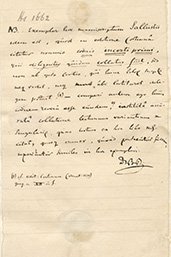
A note in Latin is glued to the second endleaf at the beginning (fol. ii-r). Unfortunately, its author did not provide us with a date when it was written and his name remains unknown since his autograph is practically undecipherable (Di…?). Nevertheless, the author must have studied the manuscript carefully. He states that Gottlieb Kortte did not make use of this manuscript in his 1737 edition of Sallust (Cortius 1737; his first edition was published in 1724) since he was not able to locate it. The note does not refer to the edition of Haverkamp of 1742.
The anonymous writer then tells us that he has compared the text of this manuscript with the variant readings in Kortte’s edition, and found that it matched the text of manuscripts Kortte often cites. Unfortunately, the author of the note is not exactly clear which manuscripts matched ours. Nevertheless, based on the work of this anonymous source it seems our manuscript was not a vital witness in the creation of an edition of Sallust’s text. Indeed, in Leighton Reynold’s recent scholarly edition of Sallust’s works (1991), our Utrecht manuscript is not consulted. However, that does of course not mean it is not worth examining further.
Keeping up appearances
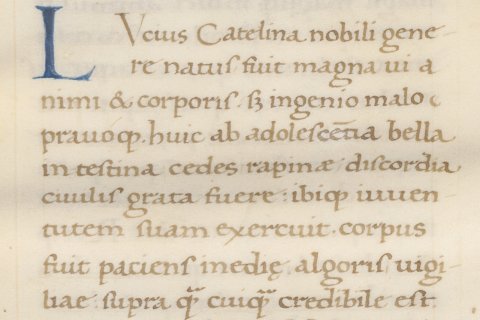
At first sight, the manuscript appears to be a careful production. The wide margins give it value for their aesthetic and status purposes. The luxurious and intricate white vine initial ‘O’ on the title page and the letters in red, blue and mauve also suggest a manuscript of some quality. The capital L and V (U) at fol. 4r and 5r (chapters 5 and 6) are in line with this, and the text is written in elegant Italian humanistic script, clearly an imitation of a Caroline minuscule. Van der Horst (1989, 48) assigns the manuscript to the second half of the fifteenth century and to Naples with a question mark.
However, no coloured capital letters are found after fol. 5r. The Bellum Jugurthinum begins at fol. 52r, and here the space left open has only been filled with a small capital ‘F’ in dark ink, and the same occurs on fol. 55r with the capital ‘B’. In other words, the manuscript was never properly finished. There are also many corrections to the text contemporary to its writing, either by expunging (marking letters redundant by putting dots underneath it), crossing out or inserting words by using a %-like sign as a reference mark (e.g. fol. 2r21, 3r18, 11v8, 17r4, 30v15, 50r9-10 and 15, 71r11, 72r8, 73r22, 92v21, 112r5 and 13). It is unclear whether the scribes were rather sloppy or that their copy was corrected with use of a better one.
Although the manuscript has a uniform outlook, as many as four scribes seem to have been at work, judging from the changes at fol. 18r/v, 125r6 and 130v9. The ink (colour) and pens they used seem to have changed frequently. In the lower margin on every eighth folio the scribes use a vertical catchword – not uncommon in humanistic manuscripts – surrounded by dots and lines to indicate the order of the quires (fol. 8v ‘ra’, 16v ‘omnes’, etc.). The quires are also individually marked in the right lower corner, e.g. at fol. 71 (a10), 72 (b10), 73 (c10), etc. in the tenth quire. The ruling is for a part blind ruling and for part in ink, sometimes faint, sometimes clearly visible or even thick. Most pricking marks have been cut off by the binder. The quality of the parchment ranges from good to average.
So, although it begins like a manuscript executed with some care and expertise, it turns out to be rather inconsistent in its quality and execution. Why this is the case is unclear, and manuscripts such as these have not been studied for these features.
Traces of readership
There is an absence in our manuscript of annotations in the form of glosses or commentaries. Annotations can be found in abundance in medieval manuscripts used for learning, with passages written in the margins or as interlinear glosses for clarification (see e.g. Bern, Burgerbibliothek, Cod. 165, f. 54r), in order to learn, analyse or digest a text better. This could be done by the scribe himself or herself or by later users. However, glosses are most frequently found correcting the Latin of a text (Teeuwen 2015, 42). All of these types of annotation could be expected from this text, containing two of Sallust’s influential works, given the subject matter, and influence that he had on teaching grammar. But this is not quite the case in our manuscript.
Later readers have left a number of traces. The manuscript begins with frequent underlining in ink, at fol. 1v14-16, 2r16-18, 5r15-17, 6r4-6 and 19-20, etc., the last one occurring at 14v20-22. By contrast, lines in the margin with pencil occur almost exclusively in the Bellum Jugurthinum, from 52r onwards. When these were made is unknown. Only a few clear corrections in early modern handwriting occur, at fol. 1r (transeant = transigant), 2v (iis = is) and 3r (reprehenderis = reprehendis).

In other cases it is not quite clear when corrections were made, such as with syla = sylla at 8r16 and uentos = uentus at 8r18. The uncorrected readings usually occur also in other manuscripts of Sallust. To which manuscript tradition our copy belongs still needs to be established, but we may mention one clue: the remarkable title Crispi Salusti nobilitate veritatis historici clarissimi de Coniuratione et Bello Catilinae (‘About the Conspiracy and War of Catiline by Crispus Salustus, a most learned historian famous for his truthfulness’). The Church Father Augustine calls Sallust nobilitatae veritatis historicus (De civitate Dei, I.5), in which he was followed by Petrarch (Rerum memorandarum, I.17) (Von Albrecht 1997, I, 456). This particular introduction is also found in Brussels, Royal Library, II 7842, copied in Bruges in 1473 (see Salvatore 1954, 38). Perhaps this provides a lead to know more about our manuscript’s connections.
Just like the texts of Sallust, this manuscript appears to have been used and studied for ongoing generations. This may have been because of its content, which, as we have seen, remained relevant up until the modern period. But later on scholars checked it against printed editions to see if mistakes and important variants occurred. And nowadays we may value it for its place in the Italian humanistic book production, its white vine initial, other codicological and textual features, and even its contradictory execution. Like Sallust himself, this manuscript still has things to teach us.
Authors
Ophelia Norris, Teun van Dijk, Eduard Visintini, July 2020; edited by Bart Jaski, March 2021
